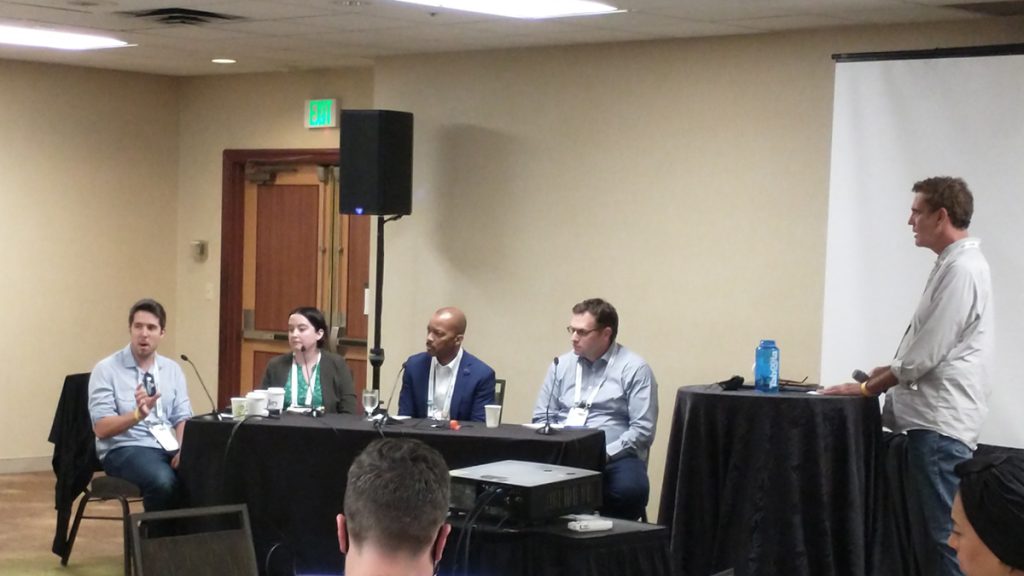
(L-R) Brian Manzullo, the social, search and audience editor at the Detroit Free Press; Theresa Poulson, senior product manager at McClatchy; Harold Goodridge, digital director at First Coast News; and David Higgerson, chief digital chief digital publisher at UK-based newspaper group Reach plc.
ONA22: Metrics and mission don’t have to stay separate
LOS ANGELES (Sept. 23, 2022) — At ONA22, yesterday’s Tech Trends talk tying the future of journalism to AI and the metaverse gave way to a discussion today about using AI and data-driven decision-making to connect more closely with audiences.
In “An Editorial-AI Hybrid Approach to Journalism,” two rising trends dominated the conversation: A/B testing of headlines and featured images, which allow editors to maximize a story’s performance by choosing the best-performing version as soon as a few minutes after the story has been published online — and personalization, an AI-driven process of changing what individuals see on a news site based on each individual’s digital footprint.
Personalization has somewhat controversial roots in its use as an invisible curator of web searches and social media feeds, practices often blamed for the prevalence of bias-reinforcing echo chambers online. But Theresa Poulson, senior product manager at McClatchy, sees in journalism an opportunity to reap the benefits of news sites that change depending on the audience while maintaining safeguards that encourage trust in the process.
“When we rolled out personalization on the Miami Herald homepage, we spent a lot of time at the beginning figuring out which positions would stay [manually] curated and which would not,” Poulson said. “There are rules around different positions on the page. For instance, we have a dedicated spot for local government and politics, and some of that zone is personalized — it might change a little bit depending on which customer is on the page, but they will always see local government and politics. We can safeguard against potentially harmful situations by setting up rules around the content and making sure the controls are always in our hands.”
In another example of keeping hands on the controls, Poulson recalled “pulling back” on personalization to ensure visitors to the website would be able to easily find information about polling places and other relevant election information.
“Increasingly, it’s not metrics vs mission, it’s using the metrics to improve how we serve communities. Look at the data, and if you don’t like what you see, how are you going to change it?”
This give and take reflects the reality that while analytics help news organizations boost their bottom line, they also help focus the decision-making process on the needs of the audience. For fellow panelist Harold Goodridge, digital director at First Coast News in Jacksonville, Florida, the audience has a hand in more than the location of a story on the page — knowing readers through data and AI-enhanced algorithms gets to the heart of storytelling itself.
“A lot of times we don’t know what the story is until we see the data,” Goodridge said. “Having been a reporter, I know what it’s like to think, ‘this story is important because it’s the story I decided to write. But joining the digital analytics side of things is quite humbling. You can’t explain away the data; you have to make sure you’re looking at ways to make decisions based on it.”
The panelists emphasized that this decision making has to be communicated clearly inside the newsroom itself, where reporters don’t always perceive that data and journalism are moving toward the same mission. Brian Manzullo, the social, search and audience editor at the Detroit Free Press, drove home the importance of communicating the value of digital tools and AI as sources of insights about audiences to the people charged with applying those insights to storytelling.
“People in the newsroom sometimes have a tendency to think, this is about robots that are going to take over our jobs,” Manzullo said. “No! This is about using technology to help us do our jobs, to learn more about our audience.”
Indeed, the panelists were optimistic that tools like A/B testing and personalization actually create more synergy between the financial and mission-oriented goals of news organizations. David Higgerson, chief digital chief digital publisher at UK-based newspaper group Reach plc, offered a call to action for those who might be hesitant to incorporate these newest digital trends into their workflows.
“Increasingly, it’s not metrics vs mission, it’s using the metrics to improve how we serve communities,” Higgerson said. “Look at the data, and if you don’t like what you see, how are you going to change it?”

Comments